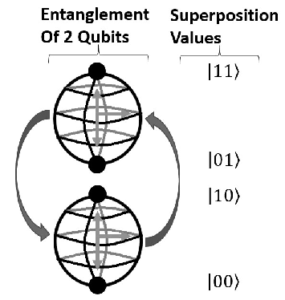Fighting Quantum Hackers
Written by: Arun Muthukkumar
Quantum computing has revolutionized the field of computer science, offering groundbreaking advancements in problem-solving and computational power. However, its potential depends on the intent of those who wield it. Once quantum computers reach maturity, their ability to break current encryption models within minutes could pose a severe threat to global security. In response to this looming challenge, researchers worldwide are actively developing quantum-resistant cryptographic methods to safeguard data against future quantum-powered cyberattacks. This ongoing effort is crucial to ensuring the security of sensitive information in the quantum era.
Understanding the Quantum Threat
Quantum computers can solve certain types of problems exponentially faster. Specifically, they can be used for factoring large numbers, search problems, and optimization problems. However, classical computers still reign in areas like arithmetic and linear algebra. They do this by leveraging principles like superposition and entanglement. Let’s dive deeper into what these are. Imagine you have a light switch. It can be either on or off, but for quantum computers, this “switch” can be on, off, or even a mix of both because of superposition! Now imagine you have two of these switches, one in your room and one in your friend’s. If you turn your light on, your friend’s light will know and turn on too–instantly, even if they’re far away! That’s because the two switches are connected from entanglement, and this lets quantum computers try lots of answers at once while sharing information super fast from entanglement.
Algorithms such as Shor’s algorithm can efficiently factor large integers, breaking widely used encryption methods like RSA and ECC. This has led to urgent efforts to design cryptographic methods immune to quantum decryption. Organizations like the National Institute of Standards and Technology (NIST) are finalizing new cryptographic standards to address the issue. NIST’s initiative involves a global competition to identify quantum-resistant algorithms. They want to conduct rigorous analysis on the candidate algorithms for all possible issues with hackers. This aims to replace vulnerable encryption methods with robust alternatives in critical systems such as financial transactions and secure communications.
Figure 1

Source: researchgate
Approaches to Quantum Security
1. Post-Quantum Cryptography Algorithms
Algorithms like CRYSTALS-Kyber and CRYSTALS-Dilithium, which rely on lattice-based cryptography, have emerged as strong candidates for PQC. Essentially, these algorithms are hiding the key in a lattice grid, and these are so giant that it’s incredibly hard to search through. A quantum computer would try to find shortcuts, but the lattice grid is so tricky and jumbled that it can’t easily figure out the right square of the key. These methods create problems that even quantum computers struggle to solve, providing a foundation for future-proof encryption.
2. Quantum Key Distribution (QKD)
Unlike PQC, QKD uses quantum mechanics to secure communication. This works by having the key based on qubits. This key would work similar to quantum particles, meaning that anytime a hacker looks at it, the key would change alerting the sender and receiver. Eavesdropping is important to stop because if an attacker can intercept the key during its exchange, they can decrypt the communication without needing to break the encryption algorithm itself. By detecting any attempts at eavesdropping during key exchanges, QKD offers unbreakable security for high-stakes applications like national defense and critical infrastructure.
3. Implementing Them in Corporate Innovations
Tech giants like IBM and Mastercard are integrating the quantum-safe cryptographic protocols that we just discussed into their systems. IBM is embedding these protocols into its cloud platforms, ensuring that sensitive data remains secure during storage and transfer. Meanwhile, Mastercard has pioneered projects to test and model post-quantum encryption strategies on virtual networks.
Applications and Future Directions
Quantum-resistant systems will fundamentally transform cybersecurity across a wide range of industries. Beyond protecting financial institutions and securing global communications, the integration of Post-Quantum Cryptography (PQC) is crucial for industries like healthcare, energy, and manufacturing. In healthcare, quantum-resistant encryption will safeguard sensitive patient data from future quantum-enabled decryption, ensuring privacy even after data is collected. In the energy sector, securing the smart grid and critical infrastructure against quantum threats is vital to prevent malicious interference. Similarly, in manufacturing, safeguarding intellectual property, like trade secrets and blueprints, from future quantum decryption attacks is key to maintaining competitive advantages. As you can see in Figure 2, NIST takes various initiatives that we’ve gone over in this article. It will continue to do this in the future because many fields will require PQC in the quest of fighting quantum hackers.
Figure 2

Source: thesslstore
Conclusion
The transition to quantum-secure systems is both a challenge and an opportunity. It involves not just algorithmic innovation, but also updates to hardware, software, and global cybersecurity policies. This is particularly pressing for organizations that store data today with the knowledge that attackers might exploit quantum computing capabilities in the future, decrypting data once quantum computers become powerful enough. Ensuring that this data remains protected for years to come will require proactive and far-reaching measures across industries. By understanding and adapting post-quantum cryptography, we can ensure a secure digital future, even in the face of quantum computational power.
References and Sources
Bedantadas. (2024). How post-quantum cryptography is reshaping cybersecurity in 2024. Retrieved from https://www.capgemini.com/us-en/insights/expert-perspectives/how-post-quantum-cryptography-is-reshaping-cybersecurity-in-2024/
Computer Security Division, I. T. L. (n.d.). Post-Quantum Cryptography: CSRC. Retrieved from https://csrc.nist.gov/projects/post-quantum-cryptography
Crane, C. (2023). A Look at Quantum Resistant Encryption & Why It’s Critical to Future Cybersecurity. Retrieved from https://www.thesslstore.com/blog/quantum-resistant-encryption-why-its-critical-to-future-cybersecurity/
(N.d.). Retrieved from https://www.researchgate.net/figure/Quantum-entanglement-21-Applications-and-implications-of-superposition-and-entanglement_fig1_383001376
Team, O. (2024). Post-quantum Cryptography in 2024. Retrieved from https://www.offsec.com/blog/post-quantum-cryptography/